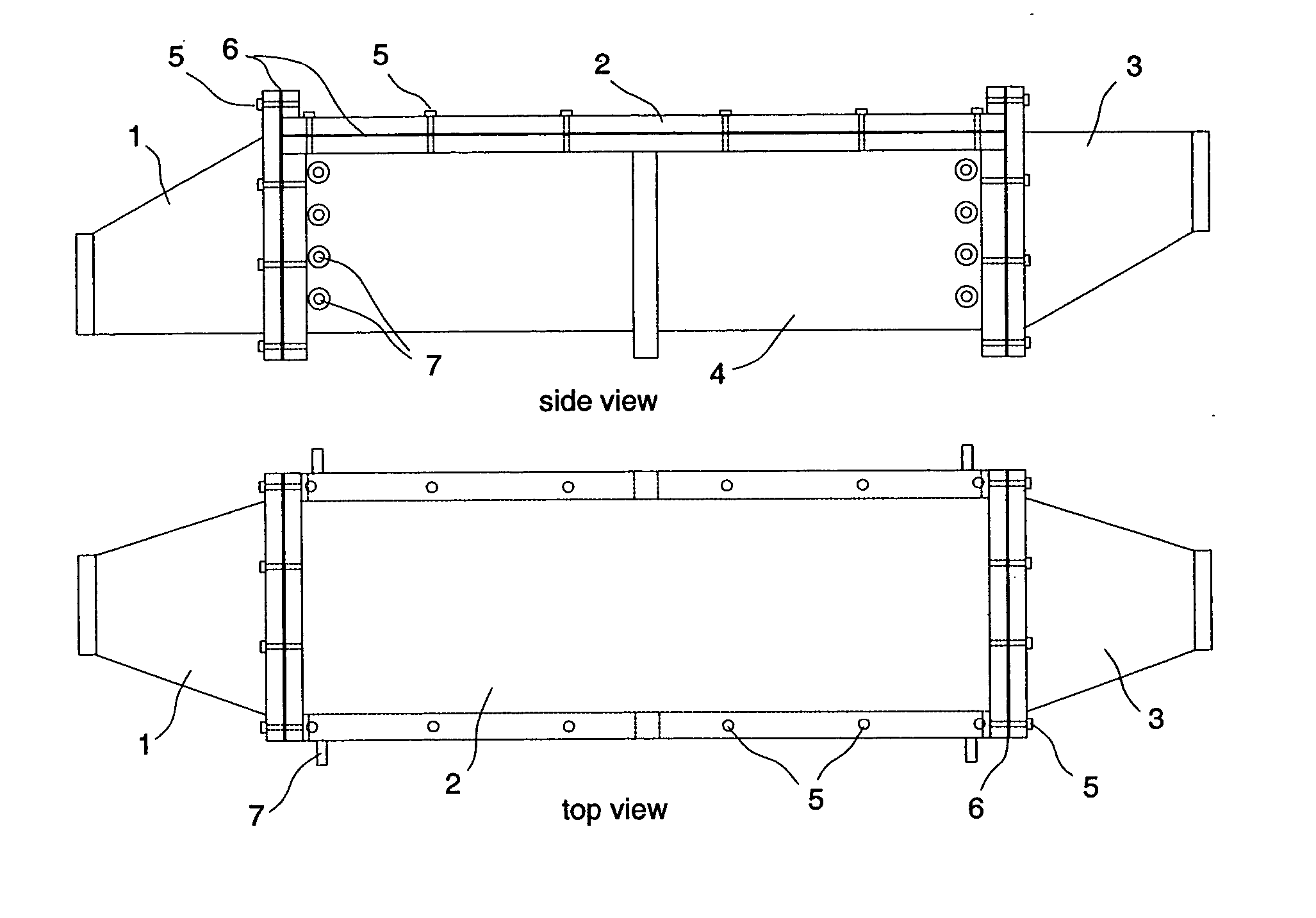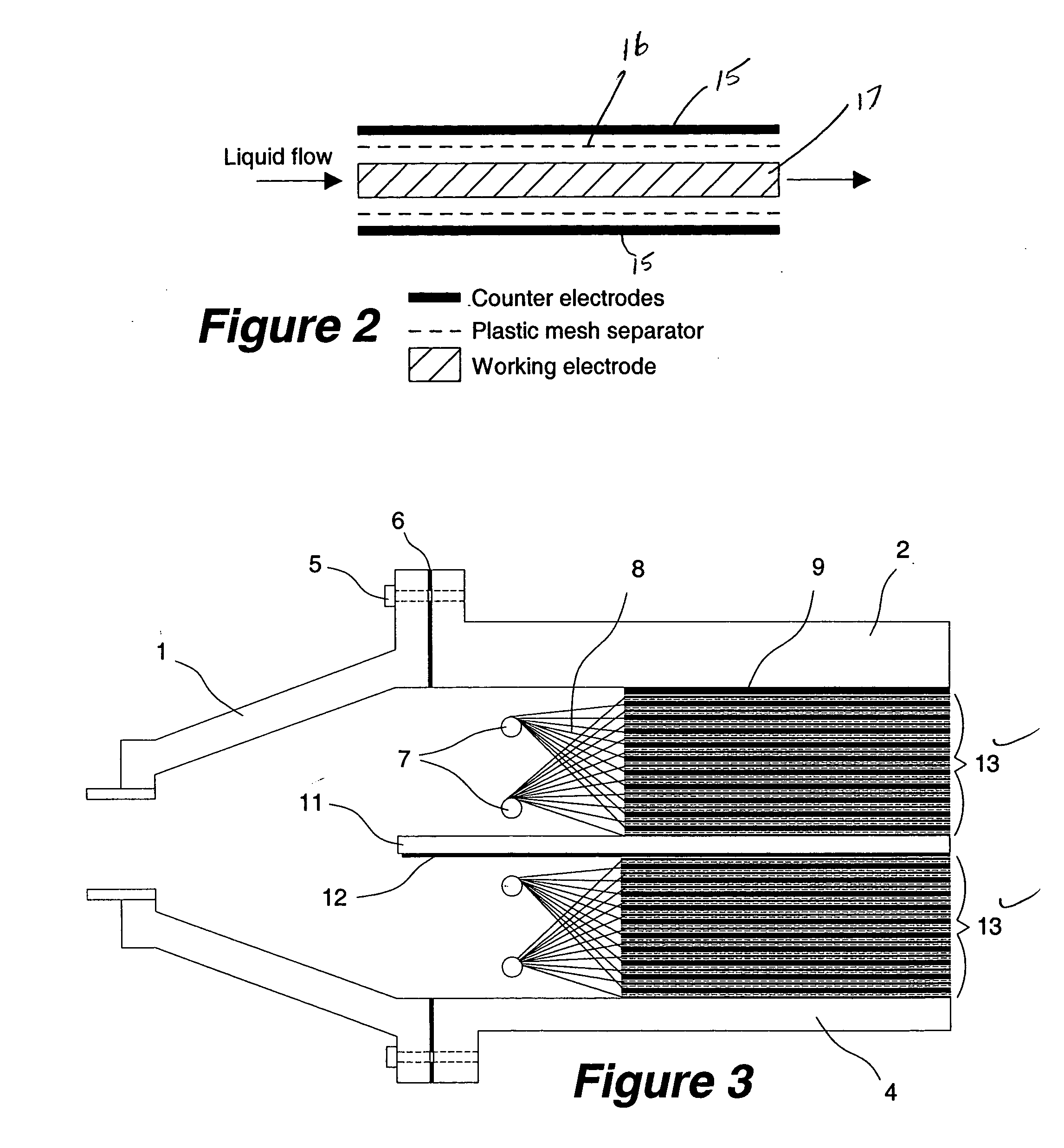High volumetric efficiency electrochemical cell design for treatment of low concentrations of contaminants in low conductivity water
- Summary
- Abstract
- Description
- Claims
- Application Information
AI Technical Summary
Problems solved by technology
Method used
Image
Examples
example 1
System Mass Transfer Performance
[0042] A superficial channel fluid velocity of 25 cm / s was achieved with less than 5 psi pressure drop (hence a larger scale 1 m electrode length cell would have an acceptable inlet pressure drop of about 15 psi under these conditions). The superficial channel fluid velocity is, in this case, the entrance velocity to each of the channels formed by a working electrode and its pair of polymer mesh separators (as solid counter electrodes were used for this example). The pressure drops measured for various superficial velocities of water are shown in FIG. 8.
[0043] The system mass transfer performance was measured using a ferri / ferrocyanide test solution. The ferri / ferrocyanide solution was made up with 6.1 mM ferricyanide, 1.0 mM ferrocyanide, and 0.2 M sodium sulphate giving a density of 1.02 g / ml. The cell voltage was increased until a current plateau was found. The cell was then held at a potential on the plateau and the flowrate was varied while the c...
example 2
Test Run Showing Contaminant Removal
[0044] A 10 L test solution of wastewater was treated using the test cell. The solution was recirculated at a flow rate of 7 USGPM (26.6 L / min) and with an applied current of 26 A. The concentrations of the key contaminants in the test solution (a selection of phenol compounds) were followed by sampling and analysis using solid phase microextraction then gas chromatography mass spectroscopy (SPME-GCMS). "Polyacrylate Film Fiber for Solid Phase Microextration of Polar Semivolatiles from Water", Application note 17, Supelco, Bellefonte, Pa., (1998) describes SPME-GCMS. The cell ran with an average pressure drop of 4.6 psi, and stack module voltages of 3.08 V and 3.09 V giving a cell voltage of 6.17 V (the solution resistance being 57 ohmcm). Over the course of the run the cell temperature increased from 23.degree. C. to 41.degree. C. As can be seen in FIG. 10 the phenols were rapidly removed with the total concentration of the phenols being reduced ...
example 3
Test Run Showing Cell Self-Heating
[0045] The cell was run in the same manner as described in Example 2, but with a different wastewater solution (31000 ppb total concentration of phenols, 4500 ppm COD, and a solution resistance of 116 ohmcm). In this case the system was insulated to retain the heat generated by the electrochemical cell and the pump. While this test solution started at around 15.degree. C., by the end of the run the solution had reached 64.degree. C., without the use of any supplemental heating. In fact, over the course of the experiment as the solution temperature increased, the cell voltage decreased from around 7.0 V to 6.2 V, resulting in a power savings. After running 13.75 h the total concentration of the phenols was reduced to about 60 ppb, and the COD to about 4200 ppm.
PUM
| Property | Measurement | Unit |
|---|---|---|
| Pressure | aaaaa | aaaaa |
| Electrical conductivity | aaaaa | aaaaa |
| Mass | aaaaa | aaaaa |
Abstract
Description
Claims
Application Information
 Login to View More
Login to View More - R&D
- Intellectual Property
- Life Sciences
- Materials
- Tech Scout
- Unparalleled Data Quality
- Higher Quality Content
- 60% Fewer Hallucinations
Browse by: Latest US Patents, China's latest patents, Technical Efficacy Thesaurus, Application Domain, Technology Topic, Popular Technical Reports.
© 2025 PatSnap. All rights reserved.Legal|Privacy policy|Modern Slavery Act Transparency Statement|Sitemap|About US| Contact US: help@patsnap.com



